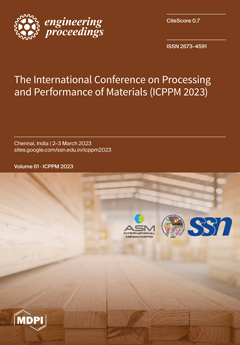Eng. Proc., 2024, ICPPM 2023
The International Conference on Processing and Performance of Materials (ICPPM 2023)
Chennai, India | 2–3 March 2023
Volume Editors:
K. Babu, Sri Sivasubramaniya Nadar College of Engineering, India
Anirudh Venkatraman Krishnan, Sri Sivasubramaniya Nadar College of Engineering, India
K. Jayakumar, Sri Sivasubramaniya Nadar College of Engineering, India
M. Dhananchezian, Sri Sivasubramaniya Nadar College of Engineering, India
- Issues are regarded as officially published after their release is announced to the table of contents alert mailing list.
- You may sign up for e-mail alerts to receive table of contents of newly released issues.
- PDF is the official format for papers published in both, html and pdf forms. To view the papers in pdf format, click on the "PDF Full-text" link, and use the free Adobe Reader to open them.




